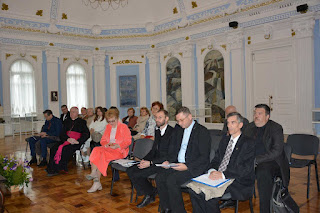  Events Archive Events Archive
Scientific Conference with International Participation "Saint John Paul II and the Catholic Church in the Republic of Moldova" and the Opening of the Exhibition "Saint John Paul II"
October 15, 2024
On October 15, 2024, the National Museum of History of Moldova, in partnership with the Roman Catholic Diocese of Chișinău and the Embassy of the Republic of Poland, organized the scientific conference with international participation titled "Saint John Paul II and the Catholic Church in the Republic of Moldova." The event took place in the Blue Hall of the museum, bringing together specialists and researchers from various fields. The conference aimed to explore the influence and legacy of Saint John Paul II on the Catholic Church and society in the Republic of Moldova, addressing themes relevant to recent history and the role of faith in community life. The conference included communication sessions where the following relevant topics were discussed: • Ion Gumenâi (National Archives Agency/USM): "The Influence of the Catholic Church in the Moldavian SSR in the 1980s" - An overview of social and political changes.
• Fr. Petru Ciobanu (Roman Catholic Diocese of Chișinău): "The Establishment of the Apostolic Administration for Moldova" - The relevance of this institution for the Catholic community.
• Anna Skowronek (Adam Mickiewicz University): "The Formation of the Catholic Church in Bessarabia" - Historical context and development.
• Anatol Petrencu (USM): "Pope John Paul II and the Fall of Communism" - Moral and spiritual influence.
• Fr. Fabian Doboș (Al.I. Cuza University): "The Pope's Visit to Romania" - Key events and reactions.
• Anton Coșa (Museum of History, Bacău): "The Coat of Arms of Pope John Paul II" - The significance of its symbols.
• Lilia Zabolotnaia (National Museum of History of Moldova): "Nelea Saganova - Historian of the Catholic Church in Moldova" - Impact on historical research.
• Fr. Alois Moraru (Roman Catholic Diocese of Iași): "Relations Between the Dioceses of Iași and Chișinău" - History of collaboration.
In conclusion, Fr. Petru Ciobanu presented "The Altar of Gratitude," dedicated to the 39 members of the Catholic clergy who served in the Republic of Moldova, highlighting the significant contributions of each member. He emphasized important details from their biographies, including pastoral activities, community involvement, and their impact on the development of the Catholic Church in the region. This tribute recognized the dedication and sacrifices made by these spiritual leaders in support of faith and human values. Additionally, during the conference, the opening of the exhibition dedicated to Saint John Paul II took place. The event included presentations by special guests and experts, who discussed the influence and legacy of this spiritual leader. Information panels placed along the museum's fence offered visitors the opportunity to explore the life and work of John Paul II, highlighting his achievements and the challenges faced during his papacy. In conclusion, a word of thanks was offered, reaffirming the Catholic community's commitment to interreligious dialogue. Following this, His Excellency Anton Coșa, Roman Catholic Diocese of Chișinău, led a prayer for peace, emphasizing the desire for harmony among all religious communities.
The exhibition will remain open to the public until October 31, 2024.
|




























































